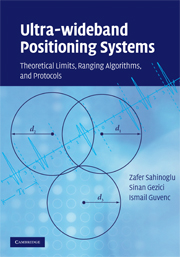Book contents
- Frontmatter
- Contents
- Preface
- 1 Introduction
- 2 Ultra-wideband signals
- 3 Ultra-wideband channel models
- 4 Position estimation techniques
- 5 Time-based ranging via UWB radios
- 6 Ranging protocols
- 7 Special topics in ranging
- 8 Practical considerations for UWB system design
- 9 Recent developments and future research directions
- References
- Index
5 - Time-based ranging via UWB radios
Published online by Cambridge University Press: 23 December 2009
- Frontmatter
- Contents
- Preface
- 1 Introduction
- 2 Ultra-wideband signals
- 3 Ultra-wideband channel models
- 4 Position estimation techniques
- 5 Time-based ranging via UWB radios
- 6 Ranging protocols
- 7 Special topics in ranging
- 8 Practical considerations for UWB system design
- 9 Recent developments and future research directions
- References
- Index
Summary
As discussed in the previous chapter, the position of a mobile node in a wireless network can be estimated based on AOA, RSS, TOA, and/or TDOA of received signals. Due to their large bandwidths, UWB signals have very high time resolution, hence individual multipath components (MPCs) can be resolved at the receiver. While AOA, TOA, and TDOA approaches all benefit from this high resolution, AOA-based implementations have high complexity. Therefore, positioning based on TOA (or TDOA) estimation is the method of choice in UWB-based positioning systems [196] as opposed to AOA or RSS (which has low ranging accuracy)-based approaches. Therefore, the emphasis of this chapter is on time-based UWB ranging techniques.
The chapter is organized as follows. In Section 5.1, the time-based positioning problem is briefly re-visited and importance of accurate ranging for precise positioning is emphasized. The error sources in time-based ranging are discussed in Section 5.2. In Section 5.3, the time-based ranging problem is formulated and models for various transceiver types are studied. Section 5.4 reviews fundamental limits on the accuracy of time-based ranging, Section 5.5 investigates maximum likelihood (ML)-based techniques, and Section 5.6 presents alternative low-complexity ranging algorithms for UWB systems.
Time-based positioning
Consider a wireless network in which there are Nm reference nodes (RNs). The ith RN is located at (xi, yi), and a target node (TN) at position (x, y).
- Type
- Chapter
- Information
- Ultra-wideband Positioning SystemsTheoretical Limits, Ranging Algorithms, and Protocols, pp. 101 - 147Publisher: Cambridge University PressPrint publication year: 2008



